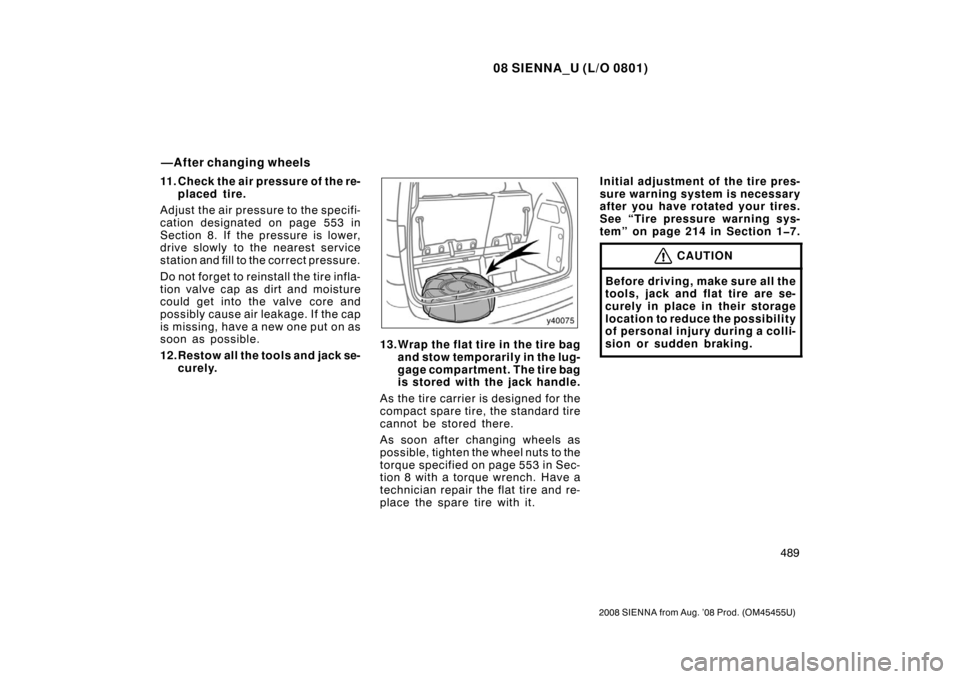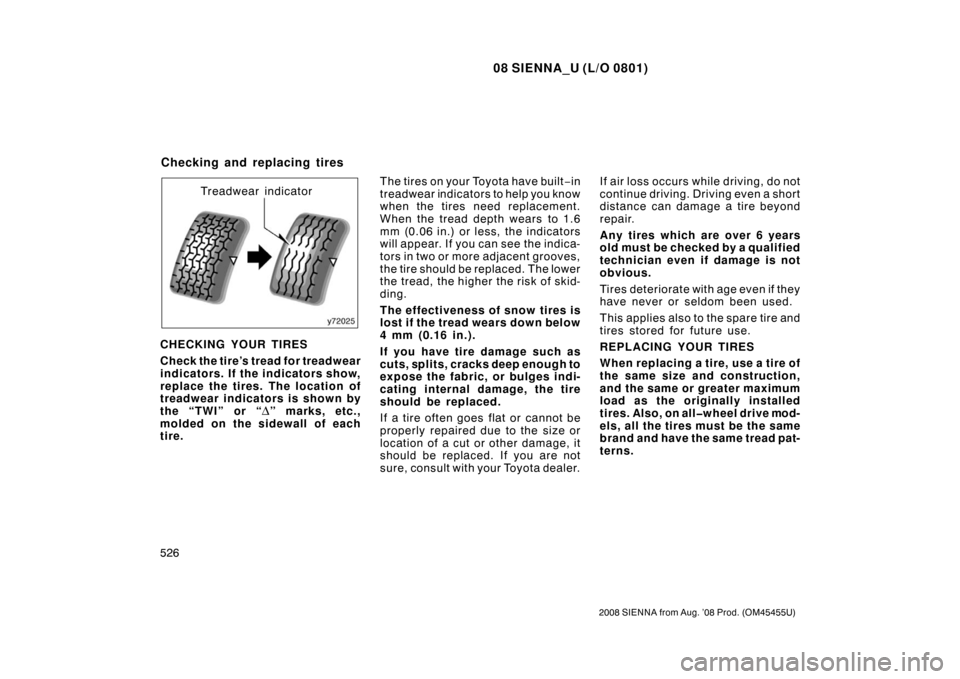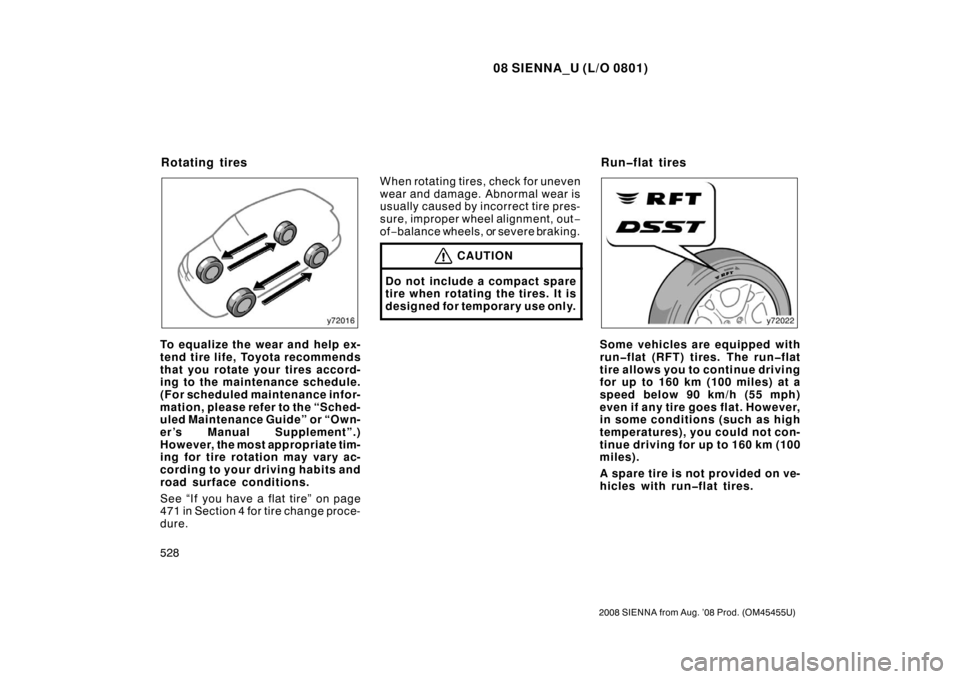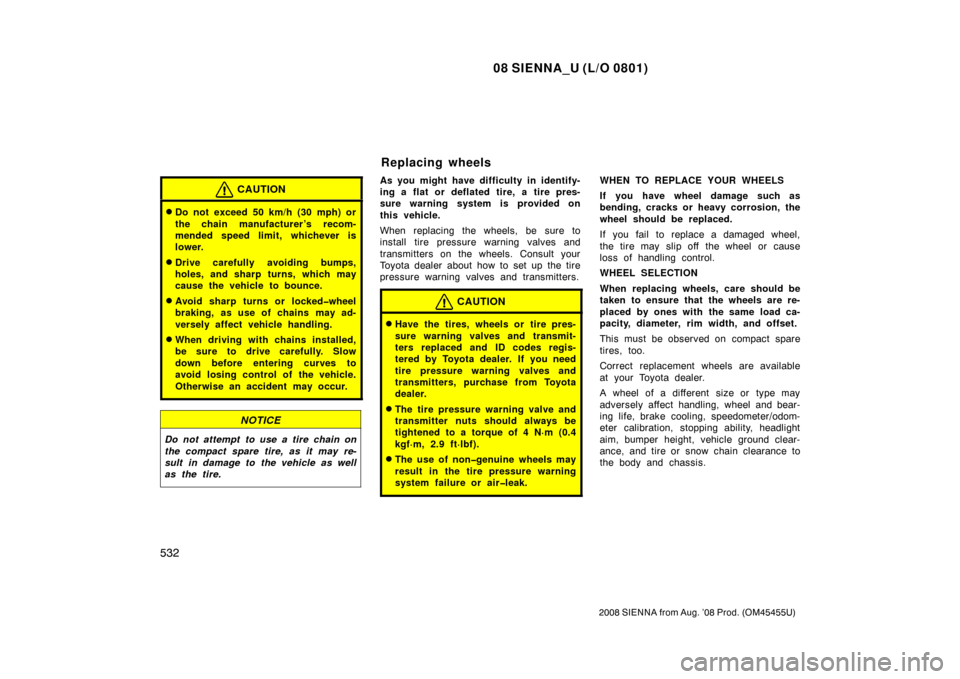Page 490 of 572
08 SIENNA_U (L/O 0801)
482
2008 SIENNA from Aug. ’08 Prod. (OM45455U)
To remove the wheel nut wrench, first
disengage the upper part of the
wrench from the holding bracket and
remove it.
When storing the wheel nut wrench,
make sure the wrench is securely
held.To remove the spare tire:
1. Remove the lid.
2. Loosen the bolt, then remove the bolt and spacer.
Then take the spare tire out of the
vehicle. When storing the spare tire, put it in
place with the outer side of the wheel
facing up. Then secure the tire by re-
peating the above removal steps in
reverse order to prevent it from flying
forward during a collision or sudden
braking.
Page 494 of 572
08 SIENNA_U (L/O 0801)
486
2008 SIENNA from Aug. ’08 Prod. (OM45455U)
CAUTION
Never get under the vehicle when
the vehicle is supported by the
jack alone.
7. Remove the wheel nuts andchange tires.
Lift the flat tire straight off and put it
aside.
Roll the spare wheel into position and
align the holes in the wheel with the
bolts. Then lift up the wheel and get
at least the top bolt started through
its hole. Wiggle the tire and press it
back over the other bolts.Before putting on wheels, remove any
corrosion on the mounting surfaces
with a wire brush or such. Installation
of wheels without good metal− to−met-
al contact at the mounting surface can
cause wheel nuts to loosen and
eventually cause a wheel to come off
while driving.
—Changing wheels
Page 497 of 572

08 SIENNA_U (L/O 0801)
489
2008 SIENNA from Aug. ’08 Prod. (OM45455U)
11. Check the air pressure of the re-placed tire.
Adjust the air pressu re to the specifi-
cation designated on page 553 in
Section 8. If the pressure is lower,
drive slowly to the nearest service
station and fill to the correct pressure.
Do not forget to reinstall the tire infla-
tion valve cap as dirt and moisture
could get into th e valve core and
possibly cause air leakage. If the cap
is missing, have a new one put on as
soon as possible.
12.Restow all the tools and jack se- curely.
13.Wrap the flat tire in the tire bagand stow temporarily in the lug-
gage compartment. The tire bag
is stored with the jack handle.
As the tire carrier is designed for the
compact spare tire, the standard tire
cannot be stored there.
As soon after changing wheels as
possible, tighten the wheel nuts to the
torque specified on page 553 in Sec-
tion 8 with a torque wrench. Have a
technician repair the flat tire and re-
place the spare tire with it. Initial adjustment of the tire pres-
sure warning system is necessary
after you have rotated your tires.
See “Tire pressure warning sys-
tem” on page 214 in Section 1�7.
CAUTION
Before driving, make sure all the
tools, jack and flat tire are se-
curely in place in their storage
location to reduce the possibility
of personal injury during a colli-
sion or sudden braking.
—After changing wheels
Page 534 of 572

08 SIENNA_U (L/O 0801)
526
2008 SIENNA from Aug. ’08 Prod. (OM45455U)
Treadwear indicator
CHECKING YOUR TIRES
Check the tire’s tread for treadwear
indicators. If the indicators show,
replace the tires. The location of
treadwear indicators is shown by
the “TWI” or “
\b” marks, etc.,
molded on the sidewall of each
tire. The tires on your Toyota have built
−in
treadwear indicators to help you know
when the tires need replacement.
When the tread depth wears to 1.6
mm (0.06 in.) or less, the indicators
will appear. If you can see the indica-
tors in two or more adjacent grooves,
the tire should be replaced. The lower
the tread, the higher the risk of skid-
ding.
The effectiveness of snow tires is
lost if the tread wears down below
4 mm (0.16 in.).
If you have tire damage such as
cuts, splits, cracks deep e nough to
expose the fabric, or bulges indi-
cating internal damage, the tire
should be repl aced.
If a tire often goes flat or cannot be
properly repaired due to the size or
location of a cut or other damage, it
should be replaced. If you are not
sure, consult with your Toyota dealer. If air loss occurs while driving, do not
continue driving. Driving even a short
distance can damage a tire beyond
repair.
An y ti res wh i ch are over 6 years
old must be checked by a qualified
technician even if damage is not
obvious.
Tires deteriorate with age even if they
have never or seldom been used.
This applies also to the spare tire and
tires stored for future use.
REPLACING YOUR TIRES
When replacing a tire, use a tire of
the same size and construction,
and the same or greater maximum
load as the originally installed
tires. Also, on all�wheel drive mod-
els, all the tires must be the same
brand and have the same tread pat-
terns.
Checking and replacing tires
Page 536 of 572

08 SIENNA_U (L/O 0801)
528
2008 SIENNA from Aug. ’08 Prod. (OM45455U)
To equalize the wear and help ex-
tend tire life, Toyota recommends
that you rotate your tires accord-
ing to the maintenance schedule.
(For scheduled maintenance infor-
mation, please refer to the “Sched-
uled Maintenance Guide” or “Own-
er’s Manual Supplement”.)
However, the most appropriate tim-
ing for tire rotation may vary ac-
cording to your driving habits and
road surface conditions.
See “If you have a flat tire” on page
471 in Section 4 for tire change proce-
dure.When rotating tires, check for uneven
wear and damage. Abnormal wear is
usually caused by incorrect tire pres-
sure, improper wheel alignment, out
−
of −balance wheels, or severe braking.
CAUTION
Do not include a compact spare
tire when rotating the tires. It is
designed for temporary use only.
Some vehicles are equipped with
run�flat (RFT) tires. The run�flat
tire allows you to continue driving
for up to 160 km (100 miles) at a
speed below 90 km/h (55 mph)
even if any tire goes flat. However,
in some conditions (such as high
temperatures), you could not con-
tinue driving for up to 160 km (100
miles).
A spare tire is not provided on ve-
hicles with run�flat tires.
Rotating tires Run�flat tires
Page 540 of 572

08 SIENNA_U (L/O 0801)
532
2008 SIENNA from Aug. ’08 Prod. (OM45455U)
CAUTION
�Do not exceed 50 km/h (30 mph) or
the chain manufacturer ’s recom-
mended speed limit, whichever is
lower.
�Drive carefully avoiding bumps,
holes, and sharp turns, which may
cause the vehicle to bounce.
�Avoid sharp turns or locked�wheel
braking, as use of chains may ad-
versely affect vehicle handling.
�When driving with chains installed,
be sure to drive carefully. Slow
down before entering curves to
avoid losing control of the vehicle.
Otherwise an accident may occur.
NOTICE
Do not attempt to use a tire chain on
the compact spare tire, as it may re-
sult in damage to the vehicle as well
as the tire.
As you might have difficulty in identify-
ing a flat or deflated tire, a tire pres-
sure warning system is provided on
this vehicle.
When replacing the wheels, be sure to
install tire pressure warning valves and
transmitters on the wheels. Consult your
Toyota dealer about how to set up the tire
pressure warning valves and transmitters.
CAUTION
�Have the tires, wheels or tire pres-
sure warning valves and transmit-
ters replaced and ID codes regis-
tered by Toyota dealer. If you need
tire pressure warning valves and
transmitters, purchase from Toyota
dealer.
�The tire pressure warning valve and
transmitter nuts should always be
tightened to a torque of 4 N·m (0.4
kgf·m, 2.9 ft·lbf).
�The use of non�genuine wheels may
result in the tire pressure warning
system failure or air�leak.
WHEN TO REPLACE YOUR WHEELS
If you have wheel damage such as
bending, cracks or heavy corrosion, the
wheel should be replaced.
If you fail to replace a damaged wheel,
the tire may slip off the wheel or cause
loss of handling control.
WHEEL SELECTION
When replacing wheels, care should be
taken to ensure that the wheels are re-
placed by ones with the same load ca-
pacity, diameter, rim width, and offset.
This must be observed on compact spare
tires, too.
Correct replacement wheels are available
at your Toyota dealer.
A wheel of a different size or type may
adversely affect handling, wheel and bear-
ing life, brake cooling, speedometer/odom-
eter calibration, stopping ability, headlight
aim, bumper height, vehicle ground clear-
ance, and tire or snow chain clearance to
the body and chassis.
Replacing wheels
Page 561 of 572
08 SIENNA_U (L/O 0801)
553
2008 SIENNA from Aug. ’08 Prod. (OM45455U)
Tire size and cold tire inflation pressure:
Front and rearTi r e siz e
Tire inflation pressure kPa (kgf/cm2 or bar, psi)Wheel sizeFrontRear
P215/65R16 96T240 (2.4, 35)240 (2.4, 35)16�61/2JJ
P225/60R17 98T240 (2.4, 35)240 (2.4, 35)17 �61/2J
Spare
Ti r e siz e
Tire inflation pressure kPa (kgf/cm2 or bar, psi)Wheel sizeFrontRear
T155/80R17 101M420 (4.2, 60)420 (4.2, 60)17�4T
W h eel nu t to rq u e, N·m (kg f· m, ft· l b f ) :
103 (10.5, 76)
NOTE: For a complete information on tires (e.g. replacing ti res or replacing wheels), see “Checking tire inflation pres-
sure” through “Aluminum wheel precautions”, pages 523 through 533, in Section 7 −2.
Tires